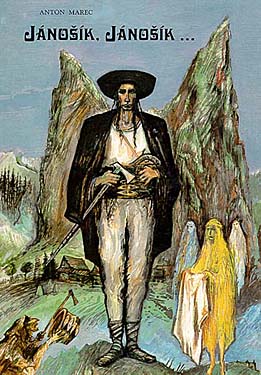|
ANTON MAREC
JÁNOŠÍK,
JÁNOŠÍK...

Publisher Matica Slovenská 1995
This book is in English
The book (102 pages)
33 tales from the legend of famous outlaw
captain
At the time of Jánošík’s
life, what is now the Slovak Republic was part of Uhorsko (old Hungary),
which also included Hungary, Transylvania, southern Poland, and
Zakarpathian Ukraine. Slovakia did not exist as a state and the official
language spoken by the nobility was Hungarian, the serfs spoke Slovak.
Uhorsko was associated with Austria under the Habsburg Emperor Karol VI
and took part in the war for the Spanish throne after the death of the
Spanish King Charles II. The war plundered the serfs who had to contribute
as well as the lower nobility. According to the law of the time the serfs
had to pay tithes and taxes and were also forced to work on the
landlords’ fields by the drábi. The Hungarian nobility then used
the serfs in the revolt against the Habsburgs led by Rákoczi who ruled
over the land in 1703 and 1704. He was winning until 1706 but was defeated
in 1708 by the Austrian army (near Trenčín). The war ended with the
signing of the peace at Szatmár by the Habsburgs in 1711. Jánošík
lived in the period of late feudalism, the last phase of serfdom. He
robbed for six years and fought against the oppression of the lords in
north‑west Slovakia. The tradition of Jánošík’s struggle was
against feudalism and later became national and social.
As a stranger to Slovakia the discovery of the tale of Jánošík is an
important part in learning about Slovak history and culture. One of the
most interesting aspects of this story is that the personality of Jánošík
and the many tales and legends, which have formed about him, are based on
a real and determinable person. Juraj Jánošík, the son of a peasant
(serf), was born in the small village of Terchová in 1688 and executed in
1713. From 1706 to 1708 he was in the revolutionary kuruc army of František
Rákoczi II. After the suppression of the kuruc uprising in 1711, in the
town of Bytča he met a kuruc named Tomáš Uhorčík who he
helped to escape from prison. He later joined up with other kurucs who had
formed a band of outlaws with Uhorčík, possibly to keep the spirit
of the revolt alive, and became their captain. They robbed noblemen and
rich townsmen in middle and northern Slovakia, Poland, Silesia, and
Moravia and (according to legend) gave to the poor. In winter they hid
in villages and out of the way places, moving often. In
October 1712 Jánošík was arrested by the drábi and imprisoned, but he
managed to escape. He was caught again in early 1713 in the region of
Liptov and taken to the county court in Liptovský Mikuláš where he
stood trial and was executed on March 17. He refused to answer his
accusers, even after being tortured, and died hung by his lower rib on a
hook. He is the hero of many tales and legends and is celebrated in
songs and dances, literature and art. The tradition of Jánošík is still
alive today and can be observed in many areas of Slovak Life.
Perhaps the most significant aspect of Jánošík’s story can only be
formulated as enigmatic question; why did this man, above all others,
become the focal point for so many tales and legends?
John
L. Doyle
Hard cover, 102 pages, the
book is 8 1/4 x 11 1/2 inches
SOLD
OUT
COST US $39.95
plus US$11.95 shipping
and handling
TOTAL US$51.90
Please mail
personal check to:
Vladimir Linder
3804 Yale Street
Burnaby, BC, V5C 1P
Phone:
1-604-291-8065, Cell:1-604-889-4616
email
me if interested
GO
BACK TO SHOPPING
GO
BACK TO BOOKS
|